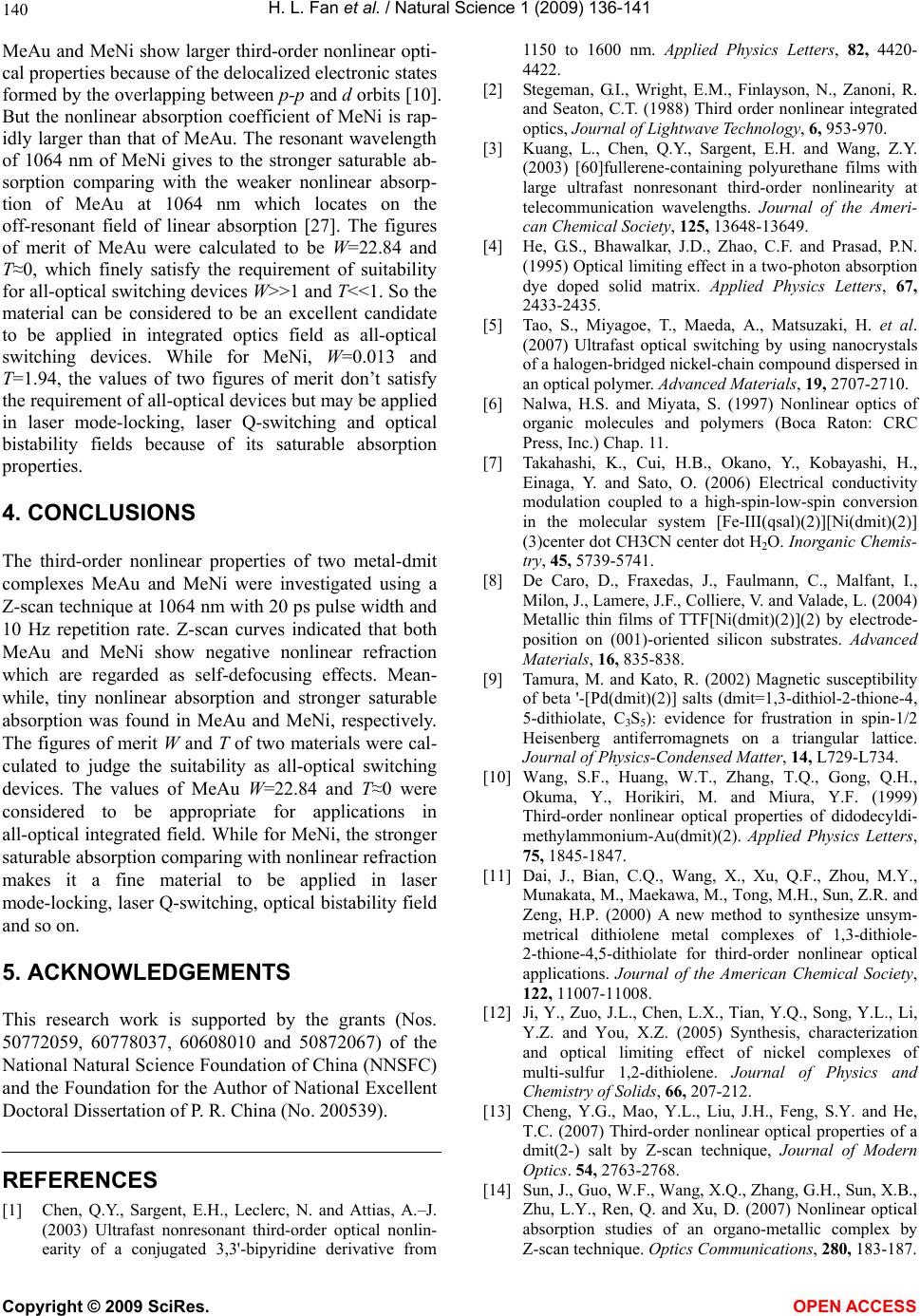
H. L. Fan et al. / Natural Science 1 (2009) 136-141
Copyright © 2009 SciRes. OPEN ACCESS
140
MeAu and MeNi show larger third-order nonlinear opti-
cal properties because of the delocalized electronic states
formed by the overlapping between p-p and d orbits [10].
But the nonlinear absorption coefficient of MeNi is rap-
idly larger than that of MeAu. The resonant wavelength
of 1064 nm of MeNi gives to the stronger saturable ab-
sorption comparing with the weaker nonlinear absorp-
tion of MeAu at 1064 nm which locates on the
off-resonant field of linear absorption [27]. The figures
of merit of MeAu were calculated to be W=22.84 and
T≈0, which finely satisfy the requirement of suitability
for all-optical switching devices W>>1 and T<<1. So the
material can be considered to be an excellent candidate
to be applied in integrated optics field as all-optical
switching devices. While for MeNi, W=0.013 and
T=1.94, the values of two figures of merit don’t satisfy
the requirement of all-optical devices but may be applied
in laser mode-locking, laser Q-switching and optical
bistability fields because of its saturable absorption
properties.
4. CONCLUSIONS
The third-order nonlinear properties of two metal-dmit
complexes MeAu and MeNi were investigated using a
Z-scan technique at 1064 nm with 20 ps pulse width and
10 Hz repetition rate. Z-scan curves indicated that both
MeAu and MeNi show negative nonlinear refraction
which are regarded as self-defocusing effects. Mean-
while, tiny nonlinear absorption and stronger saturable
absorption was found in MeAu and MeNi, respectively.
The figures of merit W and T of two materials were cal-
culated to judge the suitability as all-optical switching
devices. The values of MeAu W=22.84 and T≈0 were
considered to be appropriate for applications in
all-optical integrated field. While for MeNi, the stronger
saturable absorption comparing with nonlinear refraction
makes it a fine material to be applied in laser
mode-locking, laser Q-switching, optical bistability field
and so on.
5. ACKNOWLEDGEMENTS
This research work is supported by the grants (Nos.
50772059, 60778037, 60608010 and 50872067) of the
National Natural Science Foundation of China (NNSFC)
and the Foundation for the Author of National Excellent
Doctoral Dissertation of P. R. China (No. 200539).
REFERENCES
[1] Chen, Q.Y., Sargent, E.H., Leclerc, N. and Attias, A.–J.
(2003) Ultrafast nonresonant third-order optical nonlin-
earity of a conjugated 3,3'-bipyridine derivative from
1150 to 1600 nm. Applied Physics Letters, 82, 4420-
4422.
[2] Stegeman, G.I., Wright, E.M., Finlayson, N., Zanoni, R.
and Seaton, C.T. (1988) Third order nonlinear integrated
optics, Journal of Lightwave Technology, 6, 953-970.
[3] Kuang, L., Chen, Q.Y., Sargent, E.H. and Wang, Z.Y.
(2003) [60]fullerene-containing polyurethane films with
large ultrafast nonresonant third-order nonlinearity at
telecommunication wavelengths. Journal of the Ameri-
can Chemical Society, 125, 13648-13649.
[4] He, G.S., Bhawalkar, J.D., Zhao, C.F. and Prasad, P.N.
(1995) Optical limiting effect in a two-photon absorption
dye doped solid matrix. Applied Physics Letters, 67,
2433-2435.
[5] Tao, S., Miyagoe, T., Maeda, A., Matsuzaki, H. et al.
(2007) Ultrafast optical switching by using nanocrystals
of a halogen-bridged nickel-chain compound dispersed in
an optical polymer. Advanced Materials, 19, 2707-2710.
[6] Nalwa, H.S. and Miyata, S. (1997) Nonlinear optics of
organic molecules and polymers (Boca Raton: CRC
Press, Inc.) Chap. 11.
[7] Takahashi, K., Cui, H.B., Okano, Y., Kobayashi, H.,
Einaga, Y. and Sato, O. (2006) Electrical conductivity
modulation coupled to a high-spin-low-spin conversion
in the molecular system [Fe-III(qsal)(2)][Ni(dmit)(2)]
(3)center dot CH3CN center dot H2O. Inorganic Chemis-
try, 45, 5739-5741.
[8] De Caro, D., Fraxedas, J., Faulmann, C., Malfant, I.,
Milon, J., Lamere, J.F., Colliere, V. and Valade, L. (2004)
Metallic thin films of TTF[Ni(dmit)(2)](2) by electrode-
position on (001)-oriented silicon substrates. Advanced
Materials, 16, 835-838.
[9] Tamura, M. and Kato, R. (2002) Magnetic susceptibility
of beta '-[Pd(dmit)(2)] salts (dmit=1,3-dithiol-2-thione-4,
5-dithiolate, C3S5): evidence for frustration in spin-1/2
Heisenberg antiferromagnets on a triangular lattice.
Journal of Physics-Condensed Matter, 14, L729-L734.
[10] Wang, S.F., Huang, W.T., Zhang, T.Q., Gong, Q.H.,
Okuma, Y., Horikiri, M. and Miura, Y.F. (1999)
Third-order nonlinear optical properties of didodecyldi-
methylammonium-Au(dmit)(2). Applied Physics Letters,
75, 1845-1847.
[11] Dai, J., Bian, C.Q., Wang, X., Xu, Q.F., Zhou, M.Y.,
Munakata, M., Maekawa, M., Tong, M.H., Sun, Z.R. and
Zeng, H.P. (2000) A new method to synthesize unsym-
metrical dithiolene metal complexes of 1,3-dithiole-
2-thione-4,5-dithiolate for third-order nonlinear optical
applications. Journal of the American Chemical Society,
122, 11007-11008.
[12] Ji, Y., Zuo, J.L., Chen, L.X., Tian, Y.Q., Song, Y.L., Li,
Y.Z. and You, X.Z. (2005) Synthesis, characterization
and optical limiting effect of nickel complexes of
multi-sulfur 1,2-dithiolene. Journal of Physics and
Chemistry of Solids, 66, 207-212.
[13] Cheng, Y.G., Mao, Y.L., Liu, J.H., Feng, S.Y. and He,
T.C. (2007) Third-order nonlinear optical properties of a
dmit(2-) salt by Z-scan technique, Journal of Modern
Optics. 54, 2763-2768.
[14] Sun, J., Guo, W.F., Wang, X.Q., Zhang, G.H., Sun, X.B.,
Zhu, L.Y., Ren, Q. and Xu, D. (2007) Nonlinear optical
absorption studies of an organo-metallic complex by
Z-scan technique. Optics Communications, 280, 183-187.